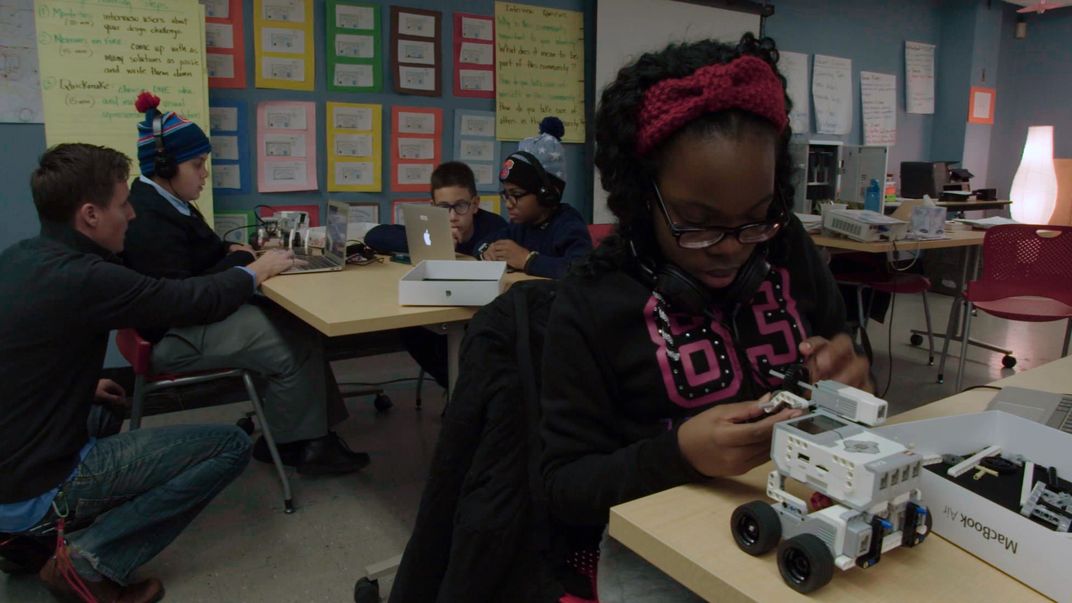The Wondrous Complexity of the New York Public Library
A new documentary captures the sweeping human impact of one of the country’s largest library systems
/https://tf-cmsv2-smithsonianmag-media.s3.amazonaws.com/filer/8d/6a/8d6a081b-d730-4e8c-974a-458770334502/nypl1.jpg)
The New York Public Library, as has been stated by many book lovers over the years, is probably the most democratic institution in New York. A subject in filmmaker Frederick Wiseman’s new documentary about the library, Ex Libris, stresses this point, and Wiseman himself thinks the claim holds water. “You have poor people, middle-class people, rich people, all involved with the library,” he says in an interview. “The library touches the lives of hundreds of thousands of people in New York.”
The film opens with a lecture held at the library by British scientist Richard Dawkins. He remarks on the dazzling sophistication of even a single human cell. Given the setting for the talk, an implicit metaphor emerges—the library is itself an organism, and each cell within has an intricate story behind it.
The New York Public Library (NYPL) network, as seen through Wiseman’s characteristically wide-ranging and nonjudgmental view, services some 18 million patrons every year. It’s the largest public library in the country after the Library of Congress, with a staggering inventory of more than 50 million individual items—books, films, cassette tapes, microfiche, newspapers—spread across 92 locations in New York City.
Founded in 1902 with the bequest of late New York governor Samuel J. Tilden, the library was conceived as an intellectual nexus for an American city soaring to prominence on the international stage. To this day, it is the object of great city pride. The leonine statues looking out from the entrance of the flagship branch in midtown Manhattan—which appear several times in Ex Libris—embody well the stalwart dedication of the institution to its mission.
Over the course of some 200 minutes—for the 87-year-old filmmaker, runtime, like age, is just a number—Wiseman serves up an entrancing array of vignettes about life at the library, tugging at heartstrings one moment and engaging the intellect the next.
The NYPL is tasked with continually serving a vast and diverse population. At a library Q&A, African-American poet Yusef Komunyakaa remarks on the inherent politics of language, while at another, an American Sign Language interpreter specializing in the translation of dramatic dialogue for the deaf describes her craft to an audience assembled at a smaller community branch. We see a curator explain to a group of students the breadth of the library’s pictorial resources, and the clever way in which they are organized by subject, and a guest speaker advocate for more accessible literature before treating a crowd to a deeply personal spoken word piece.
In another scene, African-American NYPL devotees brainstorm improvements to their kids’ education system. In another, set at a library job fair in the Bronx, New Yorkers desperate for work listen to offers from the fire department, military, border patrol and other organizations.
In the midtown branch, within the iconic reading room, library patrons sit researching in silence. They lie supine on the library lawn to take selfies, make exotic requests at the circulation desk and fiddle with their smartphones. The collective weight of the library’s humanity becomes one of its most striking aspects.

This humanity contrasts beautifully with the technology at work behind the scenes. A conveyer belt apparatus nearly 70 yards in length, a $2.3-million investment, is the largest of its kind on earth. With its aid, a crew of 14 staffers can accurately sort and route 7500 items per hour—that’s more than two every second.
According to the film, a full one-third of New Yorkers do not have internet access at home. Is the library responsible for filling that gap? Multiple scenes from the documentary show the NYPL board struggling with questions about their shifting responsibilities to the community. Strenuous debates over such matters as the acquisition of print media vs. digital and the treatment of homeless patrons enrich Wiseman's portrait of the library as a living—and ever-changing—organism.
“I wanted to show the kinds of overarching questions that senior library management has to deal with,” Wiseman says. “They are responsible for 92 branches, and thousands of employees, and lots of big issues.”
There are those who would term Ex Libris a cinematic “love letter” to the New York Public Library. Wiseman himself is more dispassionate—all he set out to produce was an accurate and compelling portrayal of a significant American place. “It’s a fair film about the library’s activities,” he says. The significance of the library to the disparate communities of New York is not a filmmaker’s contrivance, Wiseman contends, but a reality made plain by the footage he captured.
/https://tf-cmsv2-smithsonianmag-media.s3.amazonaws.com/accounts/headshot/DSC_02399_copy.jpg)


/https://tf-cmsv2-smithsonianmag-media.s3.amazonaws.com/accounts/headshot/DSC_02399_copy.jpg)